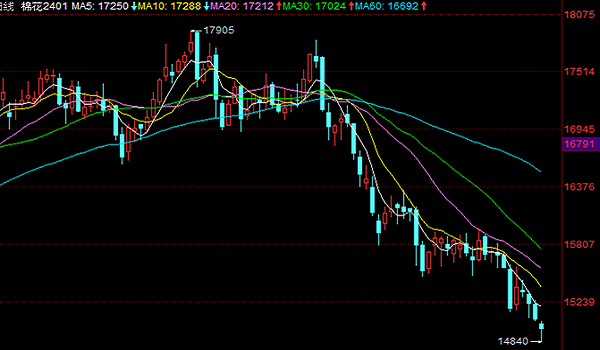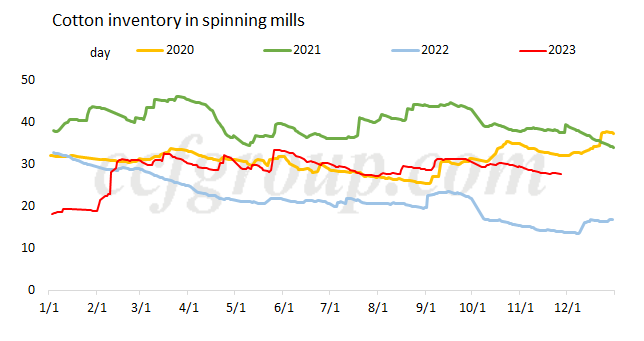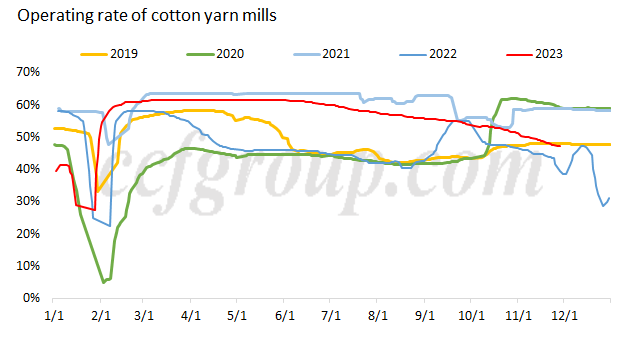ZCE cotton falls back to half a year ago, how will it fare?
Since Nov, ZCE cotton futures market has been fluctuating around 15,000-16,000yuan/mt. There is hedging pressure, but also support from the procurement costs of new cotton. Recently, the downward pressure on ZCE cotton has increased, and as of Nov 28, it closed at 15,055 yuan/mt, briefly falling below 15,000yuan/mt during trading. In the future, the direction of ZCE cotton is uncertain. It could either continue to break through support levels and decline further or make a comeback.

Currently, Xinjiang seed cotton sales have reached its final stage, and the picking of seed cotton in some regions has already ended, while the remaining areas are in a semi-stoppage state. One of the main reasons for this is the decline in seed cotton quality due to the end of procurement, and the uncertain future market trend of ZCE cotton has made ginners hesitant to purchase seed cotton. As the picking enters the later stage, the processing costs for ginners gradually become clear. In North Xinjiang, the theoretical procurement cost is between 16,700-17,000yuan/mt, while in South Xinjiang, it is slightly lower, around 16,000-16,400yuan/mt. Some ginners that purchased large quantities early on are expected to have a cost higher than this price level. The purchase price of seed cotton has also continued to decline recently, with the price in many areas of North Xinjiang being around 6.9-7.1yuan/kg. Under the current situation of declining cotton prices and seed cotton prices, the ginning cost of cotton for ginners in Xinjiang is gradually decreasing and solidifying, making it increasingly difficult for ginners.
As the cost of new cotton becomes solidified, the focus of market operation logic gradually shifts to downstream spinning mills. However, the situation for spinners is not optimistic. Most of them lack orders support, and demand for cotton in the short term is not high. The cotton inventory in spinning mills has been maintained at around 30 days. Although some mills have increased their purchases of spot cotton after the state cotton auction ended, the transaction volume has not increased significantly. The difference between large and small mills in purchasing cotton is significant. Large and medium-sized mills have timely replenished their cotton inventory through means such as state cotton auction, spot cotton, purchasing imported cotton under sliding-scale duty quotas or 1% tariff quotas. In contrast, the proportion of small mills shutting down since early Nov has been gradually increasing. In the absence of orders, small mills do not have the capability to replenish their cotton inventory. According to our investigation, the operating rate of cotton yarn mills is gradually declining and has reached a low level compared with the same period in recent years.


In conclusion, the short-term market trend is weak, and downstream orders for the rest of the year are unlikely to improve significantly. Additionally, there is not much impact during the November 11th sales event, and the next timing is expected to be around the Chinese New Year. During this period, the market may continue to fluctuate weakly. If downstream orders do not improve significantly, cotton yarn prices keep down, operating rate drops further and cotton yarn inventory is still accumulating, cotton prices may face new downside pressures. In the future, pay attention to whether there will be any improvement in downstream market.
- Top keywords
- Cotton Price
- Cotton Futures Price
- Cotton Futures
- CZCE
- PTA Futures Price
- Chemical Fiber
- Polyester Prices
- Wool price
- PTA Futures
- Shengze Silk
- China
- Yarn Price
- price
- China Textile City
- Fibre Price
- Benzene Price
- Cotton
- Index
- Cotton Index
- PTA
- fabric price
- NYMEX
- Top 10
- textile industry
- Spot Cotton
- Cotton Yarn
- Polyester Price
- Futures
- PTA Price
- cotton yarn price

